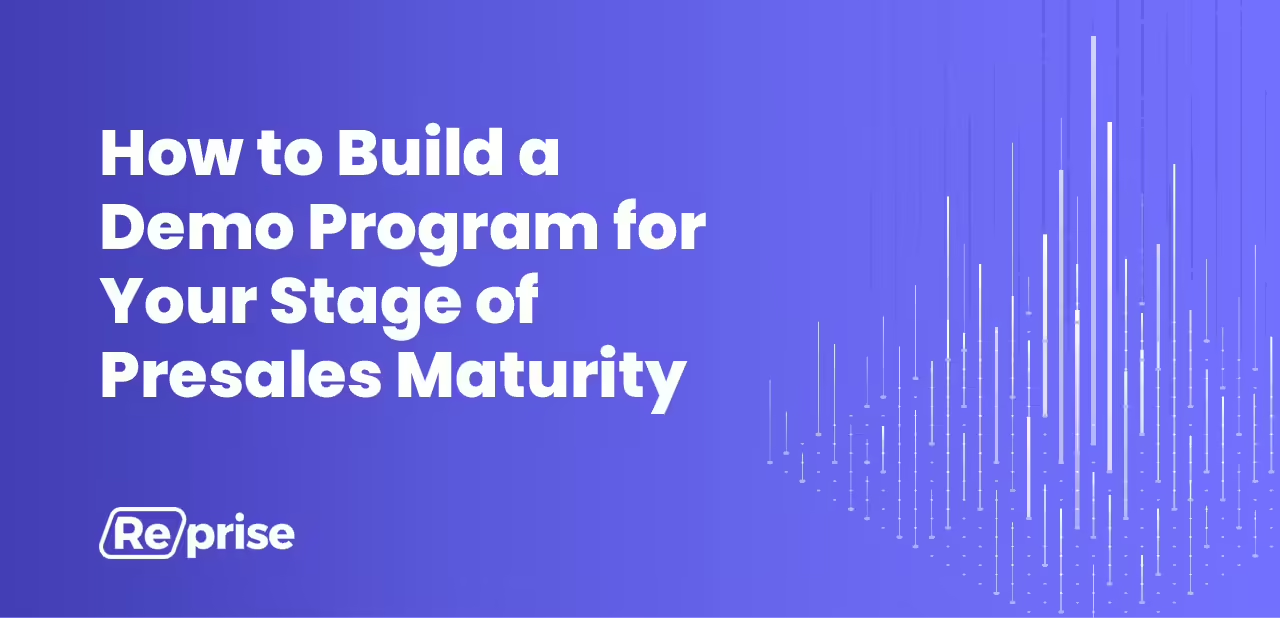Accelerate deals and increase win rates with the leading enterprise demo platform.
How to Build a Demo Program for Your Stage of Presales Maturity

October 18, 2024
Table of Contents
Some presales teams are at an early stage of maturity, are reactive to client demands, and may not have the processes they need in place. Others are highly optimized, and are positioned within their organization as a strategic partner in driving sales strategy. Regardless of where you’re at, it’s possible to get started with a demo program to advance your maturity level. A demo program will show the value of presales by equipping your organization with the tools they need to successfully demo your product and close more deals.
What is a demo program? It’s a top-down approach to building, centralizing, sharing, and analyzing your demos. Demo programs aim to provide organizational structure and governance to demos, positioning the presales function to be more productive and strategic, driving value for the entire organization.
Let’s explore how you can get started with (or advance) a demo program at each stage of maturity, as defined by the PreSales Collective.
Maturity Stage 1: Chaos
The PreSales Collective defines the “Chaos” stage of maturity as heavily manual, inconsistent, and highly adaptable. These teams may not have the processes or tools in place to support tasks. Efforts may be sporadic and uncoordinated, and the team’s isolation makes it difficult to collaborate cross-functionally. As a result, they have limited influence on sales strategy, and tend to respond to client inquiries as they arise (without a structured approach).
This stage of maturity is all too common among presales teams, who are tasked with supporting sales staff and technical client inquiries, but do not have the adequate tools and/or processes to keep up with demand. Starting a demo program at this stage of maturity will make a dramatic difference in the day-to-day lives of your SEs.
What to do with your demo program: Make the case for a demo program by keeping track of the amount of time your SEs spend building demos from scratch, or maintaining your demo environment. Calculate the costs of these hours. If your SEs were able to spend less time on repetitive or administrative tasks related to your demos, would they be able to speak with more prospects, and in turn close more deals? You have the beginnings of a great case to investigate a demo creation platform that can help your team scale the creation of demos via reusable templates and demo libraries.
Measuring success: You’ve successfully made the case for a demo creation platform, and/or have identified an initial set of demo assets that can be repurposed and templatized for a larger program.
Maturity Stage 2: Defined
The PreSales Collective says that in the “Defined” stage “tools, documentation, and processes are starting to be defined,” but with inconsistencies. Team members are beginning to collaborate more frequently, with some defined roles and responsibilities, yet their influence on sales strategy is still limited.
What to do with your demo program: At this stage, presales teams are starting to be called upon for their expertise and product knowledge within their clients’ specific scenarios and environments. This is a great stage to align key stakeholders who need to present your product story to prospects — that might include members of the presales, sales, marketing, and product teams. This alignment phase should focus on not only the role of demos at each phase of engagement; it should also include key messages you’d like to convey and the core audiences you’re trying to reach.
Measuring success: You’ve understood the priorities of each stakeholder group, and have mapped out the key messages you’d like to use in demos for each of your core audiences.
Maturity Stage 3: Progressive
At this phase in maturity, tools, metrics, and processes are widely adopted, yet onboarding and training is inconsistent. In this stage, presales is seen as an integral part of the sales process, with end-to-end support throughout the sales cycle. However, the product story may still have some inconsistencies, which may result in less-than-optimal sales outcomes and inefficiencies.
What to do with your demo program: At this stage, take your demo program to the next level by organizing demo libraries. A library of templated demos for different audience segments will set your team up for success. You can organize your demo library according to industry verticals, customer pain points, sales plays, or however your team may find the most value from them. These demo templates are also terrific enablement tools, ensuring that every sales and marketing team member is using the correct messaging to convey product value to prospects. Demo templates can be customized based on the prospect’s unique requirements.
Measuring success: You’ve created initial demo templates for each of your stakeholder groups, and have organized them in a folder or file system based on what makes most sense for your business.
Maturity Stage 4: Mature
Mature presales teams may find that their processes are becoming streamlined. They have tools in place for efficiency, and have established consistent training. These teams have seamless, well-defined processes, and are considered as subject matter experts who can provide tailored solutions to meet client demands. Considering the highly mature presales team’s grasp on product story, they can begin to drive strategic value for the product and sales team, and increase their influence in the organization.
What to do with your demo program: At this stage, you likely have the beginnings of a demo program in place, even if you haven’t formalized it. Formalizing your demo program and scaling it to meet the needs of more functions within the organization is a great step to take to increase the presales team’s influence. If you haven’t begun doing so already, measure the success of specific demos. For example, ask yourself, how well do certain demos perform in terms of close rates? Which team members do best with certain demos? How do demos work within your self-service marketing motion, and how can they be optimized or improved? From there, take action on improving your demos, and enabling team members to be more successful with them.
Measuring success: You understand which demos work best for your core audiences, and can start to improve or phase out the demo assets that aren’t converting for your team.
Maturity Stage 5: Optimized
In this stage of presales maturity, your team is operating like a well oiled machine. There’s alignment between various cross-functional stakeholders who need presales’ support, and the team is highly efficient. The presales function is seen as a primary driver of sales growth, and has a seat at the leadership table in determining sales strategy.
What to do with your demo program: At this point, your team is likely embracing demo automation, and may have a full-scale demo program already in place across multiple departments or use cases. However, consider how your demo program can drive even more strategic value for your organization. As you increase the adoption of demos throughout the enterprise, governance and security becomes a major priority. Using the right demo creation tools can help establish these security and governance foundations, making it easier to track role-based access control and keep privacy and anonymization in check.
Demo optimization should also be taking place regularly, with continuous improvement processes in place based on presenter and prospect feedback. As products or features get updated, your demo assets should be updated accordingly. For self-service demos used in marketing materials and with buying committees, demo analytics can reveal how to optimize based on what prospects care most about. They can even inform the next best action for deals that may have stalled, giving your sales team a valid reason to reach out with a highly relevant message.
Measuring success: You have established a successful governance system, and are able to make the case to IT or security teams that you’re following the proper security and compliance protocols. You’ve also created a system for collecting feedback, reviewing demo analytics, and continuously improving your demos to drive more effective sales and marketing outcomes.
At any stage of maturity, a demo program can elevate the strategic importance of your presales team, helping you evolve from a reactive, on-demand function to one that’s proactive and central to leadership team’s decision making process. The goal is to unlock more capacity for the presales team, while revealing new ways for demo stakeholders to convey the right product story to the right prospect, at the right time.
Want to learn more about getting started with a demo program?






